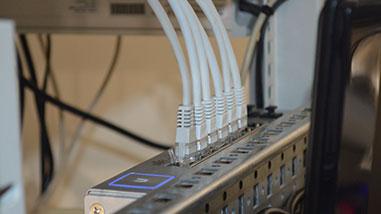A recent study states some interesting facts on network management trends, here are some of them that you should be knowing before making an informed and strategic decisions for network continuity.
We are in an always-on and ever evolving thrilling era of IT. There is a myriad of technologies that have been changing the way networks are built and accessed, how the data is transmitted and stored. Artificial Intelligence and machine learning, Cloud computing, IoT and many others provide unique opportunities for enterprises to digitally transform their business operations.
As diversified these technologies are, what unifies them is their dependence on a robust network functionality, otherwise known as ‘network continuity’. The core component to achieve that is visibility.
It is a known fact that all the latest advancements have led to driving networking best practices. With a bulk of business objectives and other critical activities heavily relying on IT, network performance is truly a matter of do or die for most of organizations. Therefore, it has become a business imperative that enterprises keep a firm grasp on the latest trends to ensure they make informed and strategic network management decisions.
To follow these trends closely, EMA (Enterprise Management Associates) released 2018 edition of their bi-annual management study. Whether it is vast outcome from cloud services and networking toolset challenges, convergence of network operations (NetOps) and IT security. The reports sheds light on various captivating themes that have evolved the network management processes and the resulting impact it has had on businesses.
New Initiative influencing network management priorities
Since past few years server virtualization was the key driving factor for network decision making by a huge margin, almost 50% of the IT companies cited that to be their 2016 top initiative. Merely virtualization will not work as we tread through 2018.
Software defined data centers (SDDCs), public cloud or infrastructure as a service (IaaS), and private cloud initiatives are now the most influential drivers behind network management decision-making.
Enterprises now require all-inclusive and deeper network performance through a host of new efficiencies leveraging the latest technology of cloud and SDDCs, managing the complexities of network processes.
With growing network complexities, complexity of understanding and resolving performance issues also has to keep pace. It is possible only through visibility into every segment of network transactions as they traverse physical networks, virtualized environments, and the cloud. Only then we can effectively identify, troubleshoot and resolve network issues, regardless of their origin.
Cloud services are flooding enterprise networks
With growing adoption of cloud, the entailing impact on the networks seem to be an important driving force behind IT decision-makers. As per EMA survey, 60% of participants suggested external public cloud traffic to be the workload presence on their network, of which 50% of their traffic volume can be traced back to their public cloud. Network performance monitoring and management can be a daunting task during cloud saturation, specifically in the absence of necessary visibility.
In practice, only 15% of network managers stated that they could oversee cloud networking with current solutions. The reason being maximum management solutions are not built to do that. Over 60% opine that they need to attain some new monitoring and troubleshooting tools for cloud services, while 14% are presently still on the hunt for the right solution.
Accurate cloud visibility solutions depend largely on what cloud is being used for. Software-as-a-Service (SaaS) functions need monitoring their service levels from the outside looking in, on the other hand Infrastructure-as-a-Service (IaaS) platforms may be greatly monitored in conjunction with the applications they are running.
The dawn of cloud services has stimulated an undisputable necessity for better insight into performance across hybrid environments.
Patchwork management solutions plague NetOps
The top most challenge in 2018 for NetOps is fragmented management solutions. 75% of IT businesses are using over ten active tools to monitor and troubleshoot their networks.
Unsurprisingly, those NetOps that are dependent on crowded roster of solutions in all probabilities will fail to detect network issues, as a result surely suffer higher volumes of network service outages annually.
Visibility is a hurdle to network operations using larger toolsets. What that means for network teams?
Often using too many specialized management solutions leads to a chaos causing miss out on an in-depth network insights compared to those network teams who easily manage only a few yet feature-rich solutions. Irrespective of the bulk of budget you allocate or use countless resources, it is highly impractical and insurmountable task to train and effectively enable your in-house network operations team to manage wide range of tools.
As opposed to that issue, users wrongly opt for their personal likes to tools, unaware of their loss of visibility and functionality. Addressing “tool sprawl” by consolidating scattered network solutions is effective and economical.
NetOps and IT Security are working in sync
Gone are the days when NetOps and IT security teams worked in silos, collaboration between the two is quite common now.
Going by the trends, 40% of EMA survey participants answered that they are completely converged with IT security, whereas 35% of enterprises have initiated the task of using security risk reduction as a yardstick to calibrate their network management achievements. And many of the network supervisors recognized their network performance monitoring and advanced network analytics as the top operations priority requiring integration with security processes.
What is the driving force behind the upward trend in collaboration between NetOps and IT security?
Enterprises have understood that these functions are more effective while in co-ordination than in isolation. The level of teamwork between NetOps and IT security will continue to grow transversely, with a shared intention of building robust network security.
Data source continues to change
In current times, the most widespread data sources in use for sustained network availability and performance monitoring are network test traffic, management system APIs and packet inspection. Additionally, the maximum prevalent data sources in use for network troubleshooting tasks include management system APIs and packet inspection.
It is in the amalgamation of insights from numerous data sources that the future of network management is possible. Firstly, the important step is to coordinate across data sources. But higher levels of coordination yield a great deal of further insight. Imagine the power when the broadest, most efficient view triggers greater attention to a specific area, and that greater attention yields specific insights that are examined in-depth. In practice, NetFlow is enabled to exactly pinpoint where the problem is stirring, deeper flow analytics can identify the problem area, and network packets can discover the actual problem source.
Outsourcing of network management
As per a report, 58% of businesses are outsourcing few or all aspects of network management, which has been constantly rising since 2014. This shift is a clear indicator of where a major chunk of IT market is headed towards – support from managed service providers (MSPs).
Presently, enterprises are outsourcing their managed services lot from WLAN networking and support, 24×7 network health monitoring, and data center monitoring, up to direct infrastructure management and configuration.
The challenge lies in whether to outsource, what to outsource, and before all that, how to ensure the transition and subsequent operation are successful, it has never been more critical for internal network managers – as well as external MSP partners – to have access to in-depth data on all network performance trends and anomalies.
Conclusion
So, what really connects these network management themes in 2018? What is the common thread?
The answer is actionable visibility – amidst all the evolving and ever-changing trends, network continuity completely relies on your enterprise or IT partner ability to not only achieve insight into what is happening on your network, but the agility and efficiency that you can do something about it.
As years go by there will be latest trends surfacing, but the consistency of IT partners should be maintained in keeping themselves educated and learn to seamlessly implement the latest trends and tools to gain network continuity through actionable visibility in their network performance!
References
Morville, P (2016): https://searchnetworking.techtarget.com/feature/Network-security-vs-network-performance-the-line-is-blurring
Zulch, L. (2018): https://www.networkworld.com/article/3285658/network-management/6-key-themes-shaping-the-future-of-network-performance-management.html
The New Age of ITSM – What to Expect and How to Prepare
The contribution of ITSM towards business value is significant, and is slowly witnessing a resurgence with the adoption of exciting new technologies. This is good news, considering that ITSM was slowly finding itself being nudged to the sidelines. Adoption of Agile, DevOps, Cloud, Automation, Machine Learning (ML) and Artifical Intelligence (AI) has given ITSM greater relevance in addition to the contribution it has already been making towards operations. The multi-faceted demands of customers, goals of business expansion and the mandate to improve productivity have spurred this adoption of technologies to transform ITSM. Here is a peek at key technological developments on the ITSM front and what organizations need to do to be ready for it.

